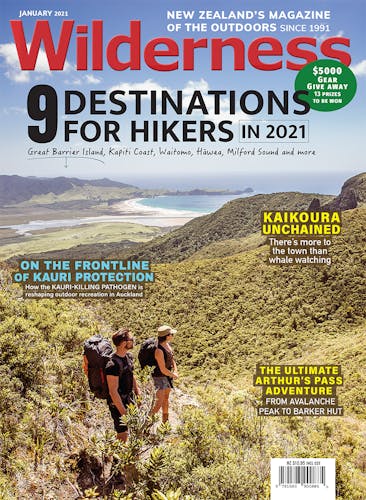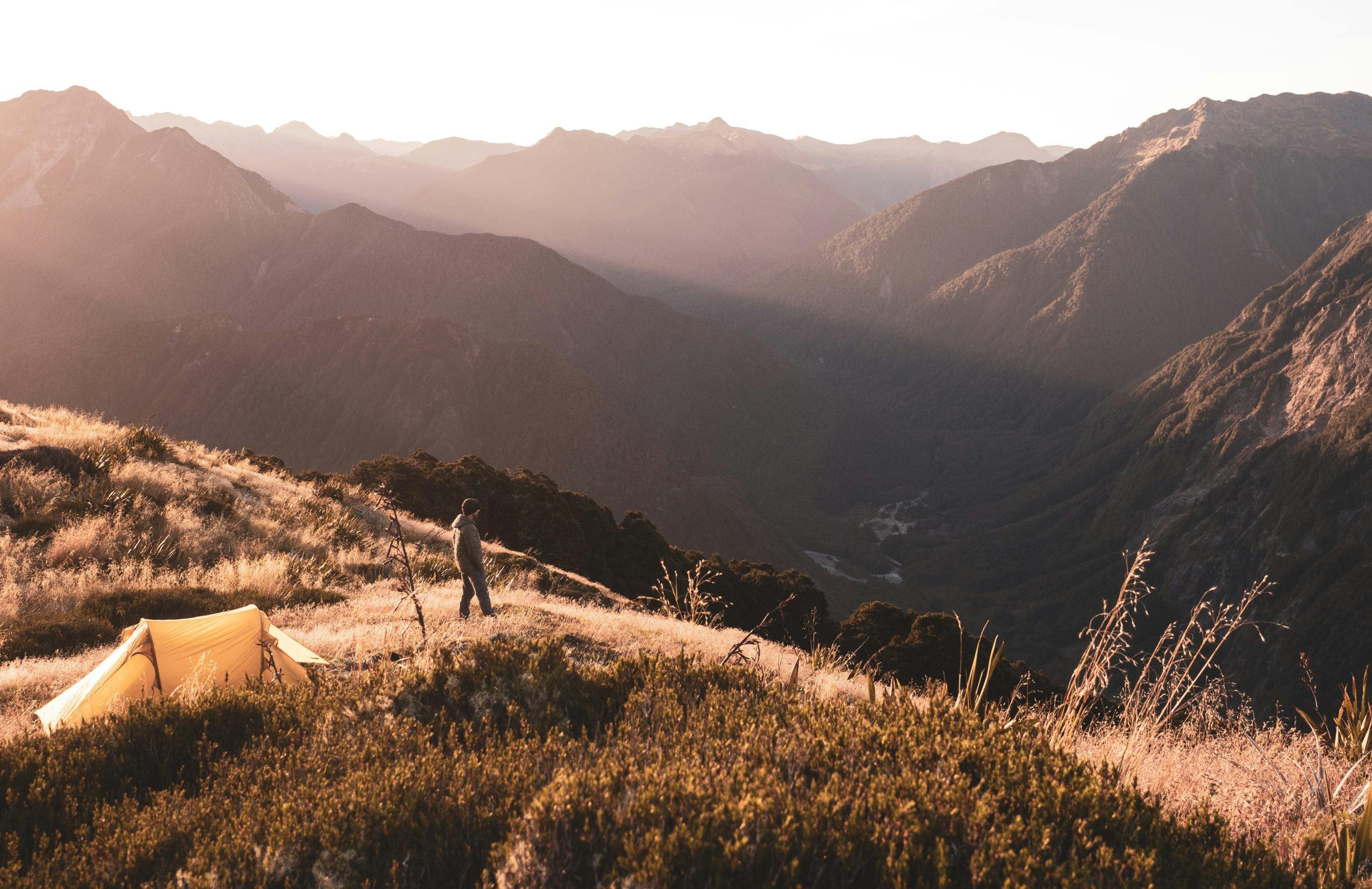Tired of cramped campgrounds and keen to foster a more symbiotic relationship with the landscape? Here’s the Wilderness guide to wild camping. By David Caudwell
Have you ever been alone with nobody for kilometres around? Whenever I find myself in wild seclusion, the wonderful emerges and things become clearer. Whether it’s relationship quandaries or life direction, everything seems so simple when watching a sunset on a mountaintop, and then rolling into bed after an audience with the stars.
But to get the most of your wild camping excursion, it pays to know your ABCs.
Adventures abound: Part of the wild camping thrill is not knowing where you’re going to end up; the flexibility of being prepared to camp anywhere creates spontaneous experiences.
Botany basics: Harakeke (flax) leaves are ideal for making splints for broken limbs; hoiheri (or lacebark) soothes gastrointestinal complaints; huika can be ground into a poultice and used to treat septic wounds. Know your flora. It could be invaluable.
Contours: Channel the mountain goat. Off-track walking is much easier when following contours to navigate up and down steep terrain. If climbing a steep, rock-strewn hill in the rain, for instance, watch for where the water runs most naturally and slowly. This will often indicate the easiest route.
Dusk deadline: Aim to be set up and settled an hour or two before dusk. Be on the lookout for potential wild camps from lunchtime onwards, in the morning sometimes if conditions sour.
Emergency beacon: Take a PLB; it could save your life.
First aid kit: Tailor your kit to the area you’re exploring. If there are sandflies, carry pawpaw cream or calamine lotion to ease the itching of bites.
Go with the flow: If it’s horizontal hailing and you can barely see your hand in front of your face, then stay put. Plans mean nothing in the face of nature.
Heightened awareness: Of emotions, of physicality, of negative belief systems. Wild camping strips everything back. Who are we when our tents are clinging to a mountain ridge in the eye of a tempest? Wild camping is a journey through both external and internal terrain.
Ingenuity: I was two days into a six-day tramp in Mt Aspiring National Park when my tent pole snapped. I repaired it by making a splint with a peg and sock and then placing rocks inside my mattress bag as a counter-weight to ease pressure on the pole.
Just get on with it: Learning to laugh in the pimpled face of adversity is essential, especially if you’re up to your waist in water or with no sight of a clear way through the bush. Wild camping breeds resilience.
Keep fire smart: Check up-to-date bushfire information before heading out.
Listen to the weather: Check the forecast before leaving home and change plans if necessary. In the field, keep an eye on the horizon for impending weather events. Be aware of prevailing weather patterns, sudden wind changes. Surrender to conditions, don’t try to control them.
Moving meditation: I strained my IT band on the first day of a seven-day tramp in Fiordland. From then on I had to walk in a specific way as a sharp pain jolted my IT band every time I walked on the outside of my foot. I was so present by the end of the hike, never before having devoted so much awareness to every footstep. It changed the way I walked.
No trace: Respect the land and other wild campers. Discarding rubbish ruins the landscape and diminishes that pioneering feel, which is increasingly more precious in a world brimming with bodies.
Orientation: Use a 1:25,000 map for off-track walking; 1:50,000 can be difficult to navigate complex terrain over short distances. A larger scale allows you to use gradient lines more accurately to pinpoint your way out of a white-out as well. Always know your precise location.
Pitch: Flat ground is a wild camper’s nirvana, but it may also be the worst place to camp. I was camping on Cow Saddle in Mt Aspiring National Park when a monster storm hit. My awning flooded. I’d camped on a floodplain and was forced to re-pitch mid-storm. Don’t camp at the lowest point. Ideally, there should be a slight slope for water to run off so you don’t get bogged.
Quiet night’s sleep: Take earplugs. They won’t quieten all noise but they will take the edge off. Include items in your supplies that will help you feel more alert after a bad night. Coffee, surplus energy bars, cacao in your muesli.
Roaming in the uncomfortable: Convenience can dull the senses. Walking in torrential rain can be invigorating. Who are we when things get uncomfortable? Wild camping will show you.
Seclusion: To sit in silence away from everything and everyone is a psychological reset. It’s nourishing for the soul.
Tracks from animals: Keep an eye out for animal trails when the going gets scrubby. They can provide an easier route but don’t follow a track too far if it starts deviating from the direction in which you’re supposed to be heading. Know when to get off. Chances are, there will be another trail going in the right direction.
Undergrowth intuition: Take the path of least resistance. Listen for trickling creeks as it may be easier to walk up the guts of one if the bush is relentless. Retrace your steps if it gets too thick. If you over-commit, consult the map, pick a point and travel in that direction. This could mean taking a bearing every five metres, picking out distinctive vegetation, beelining towards that, and then repeating the process.
Vistas: Watch sunsets and sunrises over vast, deserted landscapes with no manmade structure in sight – all from the awning of your tent.
Water: Find a site close to water, even if it’s just a puddle. Look for rocks, which sometimes accumulate water pools down the sides. Carry a water filter. Check the map for water sources emanating near mountain summits – it’s the freshest water there is.
X marks the spot: Commit and be confident in your decision making.
You never know: Embrace uncertainty. Even if it’s dusk, there’s a storm approaching and you still haven’t found a pitch. An open, calm mind is much more able to find a solution over one that’s panicking.
Zoom out: Adopt a macrocosmic perspective; always think of the bigger picture. For example, beware of camping beneath trees whose branches could potentially spear your tent. Always look for potential hazards.








